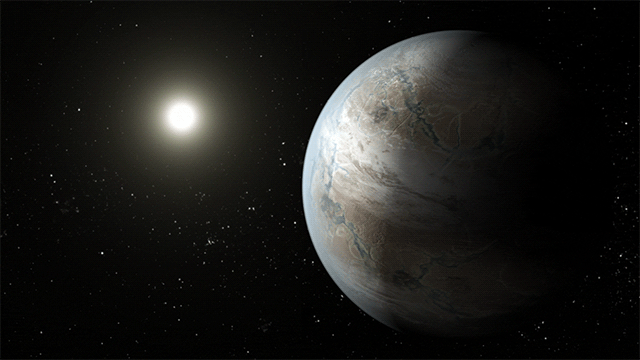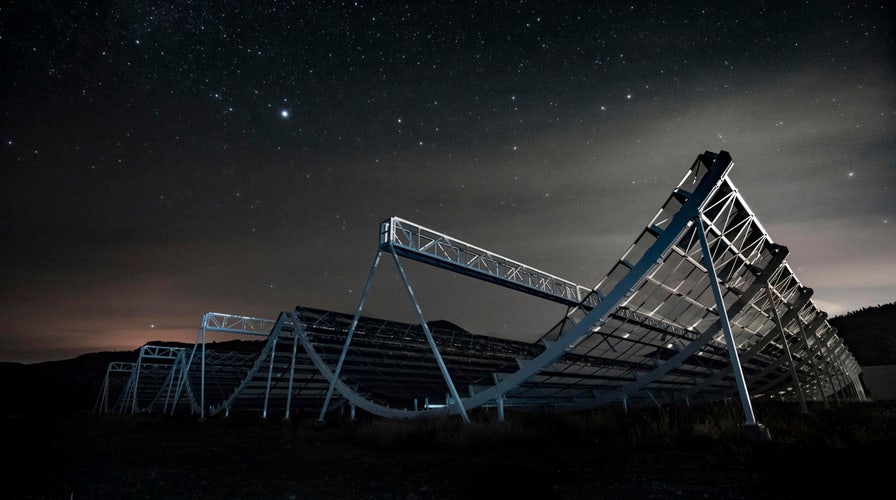Fox News Flash top headlines for December 8
Fox News Flash top headlines are here. Check out what's clicking on Foxnews.com.
The coronavirus pandemic has been the focal point for almost everyone on the planet in 2020, but there have been a number of achievements this year for those looking beyond Earth.

This illustration depicts one possible appearance of the planet Kepler-452b, the first near-Earth-size world to be found in the habitable zone of a star similar to our Sun. Credits: NASA Ames/JPL-Caltech/T. Pyle
JANUARY
In January, NASA's Transiting Exoplanet Survey Satellite (TESS) discovered its first Earth-sized planet in a star's "habitable zone," an area that could allow for liquid water to be on the surface.
Later that month, the space agency's $2.5 billion Curiosity rover became frozen on Mars. The rover, which has since started moving again, celebrated its eighth anniversary on Mars in August 2020 and has made several remarkable discoveries, including detecting an "unusually high" level of methane on the Red Planet.
LIFE ON MARS MAY HAVE LIVED BELOW SURFACE FOR THIS SHOCKING REASON
FEBRUARY
In February, researchers discovered molecular oxygen in another galaxy for the first time, located in the Markarian 231 galaxy, 561 million light-years from Earth.
Just a few days later, scientists confirmed the presence of Marsquakes, trembles on the Red Planet that are similar to earthquakes.
MARCH
March saw scientists announce the discovery of the first known protein originated in space, located in a meteorite that fell to Earth 30 years ago.
Separately in March, astronomers discovered 139 "minor planets" past Neptune's orbit. The research prompted talk that the discovery of the elusive and mysterious Planet Nine could be getting closer.
Astronomers also said they may have discovered the edge of the Milky Way galaxy in March.
The comet NEOWISE, also known as C/2020 F3, was discovered on March 27 by NASA’s Near-Earth Object Wide-field Infrared Survey Explorer space telescope.
APRIL
In April, NASA laid out its plans for putting a base on the moon in conjunction with its eventual return to the lunar surface.
Scientists said they may have discovered the "smoking gun" that changed the orbit of Uranus, "a small icy planet - roughly 1-3 times the mass of the Earth."
ELON MUSK PREDICTS HUMANS WILL BE ON MARS IN 6 YEARS
MAY
In May, researchers found a Super-Earth exoplanet they described as "one in a million" in deep space.
Although 2019 LD2 was first identified in June 2019, it was not until May 2020 that it was confirmed to be a "trojan asteroid" in Jupiter's orbit, making it the first known object of its type.
May also saw the launch of astronauts Doug Hurley and Bob Behnken to the International Space Station atop a SpaceX rocket, the first time that U.S. astronauts had launched from American soil since 2011. It was also the first time a private company, rather than a national government, has sent astronauts into orbit.
CAN ET SEE US? SOME PLANETS BEYOND SOLAR SYSTEM CAN VIEW EARTH, RESEARCHERS FIND
JUNE
In June, researchers discovered a green glow in the Martian atmosphere, the first time that's ever been seen on another planet besides Earth.
NASA said in June that there could be 'ocean worlds' all over the Milky Way Galaxy in the search for life.
JULY
NASA confirmed that the comet NEOWISE survived its encounter with the sun in early July.
Following a slight delay, NASA's Perseverance rover officially launched on July 30, heading to Mars, where it will search for evidence of ancient life.
300 MILLION HABITABLE PLANETS EXIST, NASA SAYS
AUGUST
August was a monumental month, as NASA announced that Jeanette Epps, who joined the astronaut corps in 2009, would become the first Black female astronaut on the International Space Station in 2021.
SEPTEMBER
In September, researchers discovered that the moon was "rusting," perhaps a result of the water discovered on the celestial satellite.
Later in the month, NASA found there were parts of another asteroid on the asteroid Bennu, an asteroid that may hold clues to life in the universe.
In September, a group of researchers discovered a rare molecule, phosphine, in the clouds of Venus. The gas is only made industrially or by microbes that thrive in oxygen-free environments.
Following the announcement, NASA Administrator Jim Bridenstine said Venus was “one stop in our search for life.”
SPACECRAFT MAY HUNT FOR LIFE AS IT FLIES PAST VENUS THIS WEEK
OCTOBER
In October, NASA's OSIRIS-ReX spacecraft finally touched down on the asteroid Bennu in the agency's first mission to retrieve a sample from the surface of an asteroid.
NASA made a major announcement about the moon in October, confirming that water had been spotted on the sunlit portion of the celestial satellite.
Additionally in October, the Perseverance rover reached the halfway point of its journey to Mars.
THE SUN'S LONG-LOST TWIN COULD BE IN DEEP SPACE, RESEARCHERS SUGGEST
NOVEMBER
November was a particularly busy month for space news, with NASA certifying SpaceX to carry astronauts to space, officially ending its reliance on Russia.
Just days later, NASA sent the Crew-1 mission into space onboard a SpaceX Dragon rocket, becoming the first crew rotation flight on a U.S. commercial spacecraft.
Experts said in November that they discovered the presence of water on Mars before there was life on Earth.
Despite the Trump administration's plan to return astronauts to the moon in 2024, a report issued in November said that was an overly ambitious timeline and could be pushed back.
DECEMBER
Japan’s Hayabusa2 spacecraft returned at least 100 milligrams of the near-Earth asteroid, Ryugu, on Dec. 6., after successfully "bombing" it earlier in the year.
Additionally, in December, NASA confirmed that a mysterious object that has been orbiting Earth is indeed a 1960s-era rocket from a failed mission to the moon.
CLICK HERE TO GET THE FOX NEWS APP
Fox News' James Rogers contributed to this story.





















